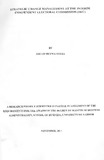| dc.description.abstract | Change management is the use of systematic methods to ensure that organizational change is guided in the planned direction, conducted in cost effective and efficient manner as well as completed within the targeted time frame and with the desired results. Strategic change management aims at aligning structures, systems, processes and behaviour to the new strategy (Ansoff and McDonnel, 1990).
This study argues that organizations exist as open systems and that is why they are always in continuous interaction with the environment in which they operate. So as to remain successful organizations are currently aligning their operations to suit the changing environment. Literatures on change management have acknowledged that given the uniquiness of each organization, there is no one theory that defines or explains organizational change. This set the background against which the study sought to establish strategic change management practices at the Interim Independent Electoral Commission (IIEC).
The study utilized a case study form of research design to collect both primary and secondary dataat the IIEC. Interview guides and focus group discussions were used to collect primary data from the sampled top management officials and representatives from selected stakeholders respectively. Secondary data was drawn from both published and unpublished works on change management. Using content analysis, the data collected was summarized according to the study themes under strategic change management practices.
The study established that IIEC embraced strategic change management practices including adoption of clear changes in organizational structure, clear forms of communication channels,
transformational leadership and information technology. These practices were consistent with Kotter’s model, rational and strategic approaches as proposed by Brewer' model. Other practices were in line with some steps as suggested by Cummings and Worley model and Victor and Franckeiss model. It was also established that change practices were driven by the IIEC strategic direction aimed at restoring public confidence in the electoral body.
The study recommends that as the IIEC transitions to Independent Electoral and Boundaries and Commission (IEBC) the new electoral body should enhance institutional foundation developed by the IIEC and formulate implementable strategies to deal with threats from external environment.
The limitation of the study was mainly the sampled respondents. Some of the top management officials at the IIEC were engaged in by-elections and preparation for transition to IEBC. Some respondents were speculative of the forthcoming changes and thus reluctant to provide the required information. All the interviews were held at the IIEC headquarter leaving out officials at the regional offices who are key at the implementation stage.This study suggests a replication of the study after the establishment of IEBC. Similarly the study should be conducted to other Agenda 4 Commissions to evaluate their performance in the office. | en_US |



